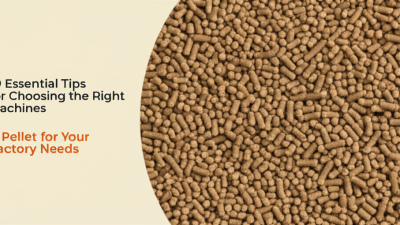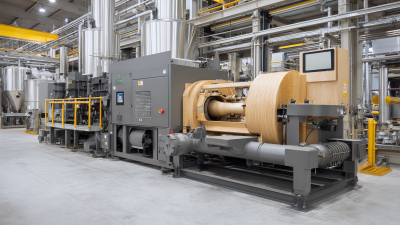10 Essential Tips for Choosing the Right Machines A Pellet for Your Factory Needs
Table of Contents
- Understanding Different Types of Pellet Machines: A Comprehensive Overview of Options
- Key Performance Indicators for Pellet Machines: What to Measure and Why
- Assessing Production Capacity: Choosing Machines that Align with Your Factory's Output Goals
- Examining Energy Efficiency Ratings in Pellet Machines: Impact on Operational Costs
- Evaluating Maintenance Requirements: Long-Term Considerations for Pellet Machine Selection
- Analyzing Cost-Benefit Factors: How to Make Financially Sound Decisions for Your Factory
- FAQS
- Conclusion
- Related Posts
When it comes to optimizing production efficiency in feed processing and aquaculture farms, selecting the right Machines A Pellet is crucial. According to the latest industry studies, the global pellet market is expected to reach $60 billion by 2025, with feed production accounting for a significant portion of this growth. As companies strive to meet rising demands, the importance of utilizing high-quality machinery cannot be overstated. At Shanghai Zhengyi Machinery Engineering Technology Manufacturing Co., Ltd. (CPSHZY), we bring over 25 years of expertise in manufacturing feed processing machinery and pellet mill dies. Our commitment to providing advanced environmental protection systems and tailored solutions positions us as a leading partner in the industry. Understanding the key factors when choosing the appropriate Machines A Pellet will not only enhance production but also contribute to sustainable practices in feed and aquaculture sectors.

Understanding Different Types of Pellet Machines: A Comprehensive Overview of Options
When it comes to selecting the right pellet machine for your factory, understanding the various types of machines available is crucial. There are primarily two categories of pellet machines: flat die and ring die. Flat die machines are typically more suitable for small-scale production and lower material density, making them ideal for farmers or small businesses. In contrast, ring die machines are designed for industrial-scale operations, offering higher efficiency and capacity, which is perfect for larger manufacturers that require a continuous production flow.
When making your choice, consider the specific requirements of your production process. One essential tip is to evaluate the material you plan to pelletize. Different machines handle varied materials differently, so ensure that the machine you choose is compatible with your raw materials. Additionally, it’s vital to think about the machine’s energy consumption and maintenance needs, as these factors can significantly influence your operational costs and overall productivity.
Lastly, do not overlook the importance of after-sales support and service. Reliable manufacturers provide ongoing support and spare parts availability, which can save you time and money in the long run. With these tips in mind, you can navigate the diverse options available, ensuring that your factory is equipped with the most suitable pellet machine for your needs.
Key Performance Indicators for Pellet Machines: What to Measure and Why
When choosing the right pellet machine for your factory needs, understanding the key performance indicators (KPIs) is crucial. These metrics help you evaluate the efficiency, output, and overall suitability of a machine for your production environment. Key factors to measure include pellet quality, production capacity, and energy consumption. These elements not only reflect the machine's performance but also impact your operational costs and product acceptance in the market.
One essential tip when selecting a pellet machine is to assess its output capacity against your production requirements. Look for machines that can handle the desired volume without compromising on quality. Additionally, consider measuring the energy consumption relative to output. A machine that offers high production rates but consumes excessive energy may not be cost-effective in the long run.
Another important KPI to watch is wear and tear on components. Frequent replacements can lead to downtime and higher maintenance costs. It's advisable to choose machines designed for durability and easy maintenance, allowing for smooth operations and reduced operational disruptions. By focusing on these critical performance metrics, you can select a pellet machine that aligns with your factory needs and enhances overall productivity.
Key Performance Indicators for Pellet Machines
Assessing Production Capacity: Choosing Machines that Align with Your Factory's Output Goals
When selecting pellet machines for your factory, it's crucial to align your choices with your production capacity and output goals. First, assess the specific demands of your production process. Understanding how much and how often you need to produce will help you identify machines that can handle your requirements efficiently. Consider factors such as the type of materials you'll be pelletizing and the expected product quality, as these will directly impact the machine's performance.
Another important tip is to evaluate the technological features of the machines. New advancements in sustainable production, similar to trends in wind turbine selection for renewable energy, suggest that integrating innovative technologies can enhance output and quality. Machines equipped with automation capabilities or advanced monitoring systems can significantly optimize operational efficiency, reducing the likelihood of errors.
Lastly, don’t overlook the importance of support and training from manufacturers. Just as operations management relies on cohesive coordination across departments, effective communication and guidance from machine suppliers can ensure that your team is well-prepared to maximize the potential of your new equipment. By focusing on these elements, you can make a well-informed decision that aligns perfectly with your factory's output goals.
Examining Energy Efficiency Ratings in Pellet Machines: Impact on Operational Costs
When selecting pellet machines for your factory, understanding energy efficiency ratings is crucial. These ratings not only reflect the machine's operational efficiency but also significantly influence your overall production costs. For instance, a machine with a higher energy efficiency rating typically consumes less power, leading to reduced energy bills over time. In an industry where margins can be tight, investing in energy-efficient machinery can result in substantial savings while also supporting sustainable practices.
At Shanghai Zhengyi Machinery Engineering Technology Manufacturing Co., Ltd. (CPSHZY), we have extensive experience of over 25 years in manufacturing feed processing machinery, including high-quality pellet mill dies. Our commitment to energy efficiency is reflected in our product designs, ensuring that our machines not only meet but exceed industry standards. By incorporating advanced technology and innovative solutions, we provide our clients with pellet machines that optimize performance and minimize energy consumption, making them ideal for feed plants and aquaculture farms aiming for both profitability and environmental responsibility.
Evaluating Maintenance Requirements: Long-Term Considerations for Pellet Machine Selection
When selecting a pellet machine for your factory, evaluating the long-term maintenance requirements is crucial for ensuring operational efficiency and minimizing downtime. A machine that is easy to maintain and has readily available replacement parts can save both time and money in the long run. Consider choosing a pellet machine with user-friendly access to the components that require regular servicing, such as rollers and dies. This not only simplifies the maintenance process but also encourages adherence to scheduled upkeep, which is vital in extending the lifespan of the equipment.
Additionally, it’s important to consider the manufacturer’s reputation and support services. A reliable manufacturer should provide comprehensive guidance on maintenance practices and offer responsive customer service. Investigate the machine’s track record—look for feedback from current users regarding the durability and effectiveness of the machine. Investing in a pellet machine that scores high on reliability and maintenance support will ultimately lead to better operational performance, allowing your factory to meet production demands without frequent interruptions.
10 Essential Tips for Choosing the Right Machines A Pellet for Your Factory Needs - Evaluating Maintenance Requirements: Long-Term Considerations for Pellet Machine Selection
| Criteria | Importance Level | Maintenance Frequency | Expected Lifespan (Years) | Cost of Ownership ($) |
|---|---|---|---|---|
| Machine Type | High | Quarterly | 10 | $50,000 |
| Energy Efficiency | Medium | Bi-annually | 12 | $30,000 |
| Parts Availability | High | Monthly | 15 | $40,000 |
| Operator Training | Medium | Annually | 8 | $20,000 |
| Technology Upgrades | Medium | Every 3 Years | 10 | $25,000 |
| Environmental Compliance | High | Annually | 15 | $45,000 |
Analyzing Cost-Benefit Factors: How to Make Financially Sound Decisions for Your Factory
When it comes to selecting pellet machines for your factory, a critical aspect that often goes unnoticed is the
cost-benefit analysis of your choices. Understanding the indirect procurement costs can significantly impact your decision-making process.
Many businesses tend to underestimate the importance of indirect procurement functions, which don't directly affect production but play a vital role in the overall efficiency and financial health of the factory.
A well-structured cost-benefit analysis can reveal potential savings and highlight the importance of smart procurement strategies.
As industries increasingly embrace the concept of smart factories, integrating advanced technologies with traditional production methodologies has become essential.
This transition is not just about automating manufacturing processes but also about making informed, data-driven decisions that enhance financial viability.
For example, leveraging artificial intelligence can optimize production logistics, reduce labor costs, and improve overall factory performance.
By focusing on the right machines and understanding the associated costs, factories can navigate the complexities of modern manufacturing while ensuring sustainability and profitability in a competitive market.
FAQS
: The two main types of pellet machines are flat die and ring die. Flat die machines are better for small-scale production, while ring die machines are suited for industrial-scale operations.
Flat die machines are typically more suitable for small businesses or farmers due to their design for lower material density and smaller-scale production.
When choosing a pellet machine, consider the specific requirements of your production process, the type of materials to pelletize, energy consumption, maintenance needs, and after-sales support.
Different machines handle materials differently, so ensuring the machine is compatible with your raw materials is crucial for effective production and quality output.
Key performance indicators to measure include pellet quality, production capacity, and energy consumption, as these affect efficiency and operational costs.
High energy consumption relative to output can make a machine cost-ineffective in the long run, so it's important to choose machines that balance production rates with energy efficiency.
Selecting machines designed for durability with easy maintenance can reduce downtime, lower maintenance costs, and ensure smooth operations.
Reliable after-sales support and availability of spare parts are crucial to saving time and money, ensuring long-term operational efficiency for your pellet machine.
Conclusion
When selecting the right Machines A Pellet for your factory, it’s crucial to consider various factors that can significantly impact productivity and operational efficiency. Understanding the different types of pellet machines available allows you to make informed decisions tailored to your specific needs. Key performance indicators, such as production capacity and energy efficiency ratings, are essential for ensuring that the machines align with your output goals and contribute positively to your operational costs.
Furthermore, evaluating the maintenance requirements of these machines is vital for long-term sustainability. By analyzing cost-benefit factors, you can ensure that your investment in pellet machines is financially sound. With over 25 years of expertise in the manufacturing of feed processing machinery and pellet mill dies, Shanghai Zhengyi Machinery Engineering Technology Manufacturing Co., Ltd. is well-equipped to guide you in selecting the ideal Machines A Pellet to optimize your factory’s performance and efficiency.
Related Posts
-

Global Excellence in Pellet Mill Parts from China's Leading Factory
-

How to Choose the Best Pellet Making Machine for Your Business Needs
-

7 Best Pellet Mill Equipment Innovations Transforming the Industry Today
-

Exploring Unique Features and Applications of the Best Feed Pellet Machine in Your Operations
-

Choosing the Right Manufacturer for the Best Pellet Making Machine for Poultry Feed and Key Comparisons
-

How to Choose the Best Forging Ring for Your Industrial Needs: A Comprehensive Guide
Blog Tags:

